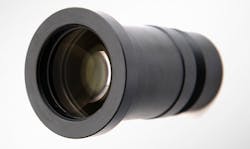Beam Expanders
Beam Expanders are optical devices which increases the diameter of the input beam to produce a larger output. Used with collimated light, they have important applications in remote sensing, interferometry, and laser scanning.
Our pre-engineered lenses give our customers the option to choose from a variety of preliminary designs based on what suits their application best. But you aren’t limited to in-stock options. Just tell us your application requirements (dimensions, wavelength range, field of view, etc.) and our team of expert engineers will optimize our preliminary designs to meet your exact needs. This will save you the hassle of fully designing a product from scratch and help reduce or eliminate design fees!
Click Here For Our In Stock Beam Expanders Page
Please contact us at 732-321-6915 or contact a representative to learn more about product availability, lead time, pricing and capabilities.
Beam Expanders Overview
Beam Expanders not only increase the diameter of a collimated laser beam, they also decrease beam divergence. The entire system does not have a focal length, i.e., both the input beam and output beam are collimated in a beam expander system. For many applications, the input laser beam has spatially varying intensity “noise” and a spatial filter is added into the beam expander system for producing a clean laser beam.
A beam expander is often an optical telescope, formed of two lenses. The two most widely used configurations include the so-called Keplerian telescope and the Galilean telescope.
Keplerian Telescope
The Keplerian telescope may be the easiest beam expander one can build. For this configuration, two plano-convex (convergent) lenses are arranged so that the distance between them is equal to the sum of their focal lengths. The focal point of the combined system will be in the gap between the lenses. Since high pulse energy density at this point may cause arcing, we do not recommend the use of Keplerian beam expanders for high energy lasers. However, Keplerian-design beam expanders are a good choice for laser applications if spatial filtering is involved. The focus point is an appropriate place to position the spatial filter.
One should also be aware that a Keplerian beam expander will invert and revert the image. A third lens can be used to correct this if desired.
1. Keplerian Telescope
Galilean Telescope
A Galilean telescope is formed of one plano-convex and one plano-concave lens. These lenses are also arranged so that the distance between them is equal to their focal length; although here the focal length of one of the lenses is negative. The distance between the lenses can be shorter than for a Keplerian beam expander, leading to a more compact system. A Galilean design beam expander does not invert the image.
2. Galilean Telescope
Applications of Beam Expanders
Beam expanders are used in many applications such as laser ranging, laser illumination, interferometry, etc. In systems with a long beam path, they are used to keep the beam collimated. They may be used to change the focus spot size for a particular focusing lens.
In high-power laser systems, beam expanders are used to increase the beam area without significantly affecting the total laser energy. This results in a reduction of the laser power density which reduce the risk of damaging the coatings and optical materials of optical components.
In a laser ranging system, a beam expander is used to minimize laser divergence, resulting in a smaller collimated beam at a long distance.
3. The light path of Beam Expander
Optical Characteristics
A beam expander is characterized by its beam expansion ratios, also sometimes referred to as the magnifying power, power, or magnification. This ratio is equal to the ratio of the focal lengths of output and input lenses. If a laser beam is expanded by a ratio of R, the divergence can be multiplied by the inverse (1/R). For instance, if the beam expansion ratio is 3, the output beam will have only 1/3 the divergence of the input beam.
A beam expander can be used in reverse to decrease a laser beam diameter, but the divergence will be significantly increased. If a beam expander is used to reduce a beam by half, the divergence will be doubled.
Our in-stock selection of beam expanders includes both fixed- and variable-magnification high-quality beam expanders for use in the UV, visible, and infrared spectral range. Variable-magnification beam expanders provide divergence adjustability. Our zoom beam expanders work with high power laser and in demanding conditions, and provide high transmittance with less energy loss.
We offer diffraction-limited collimation beam expanders for a wide range of input beams, and adjustable beam expanders which improve the divergence angle of laser beams. Our beam expanders can provide magnification from 1.5 times to 10 times, and we produce optics and coatings customized to fit specific application needs.
- Diffraction-limited collimation beams for a wide range of input beams
- Magnification from 1.5 times to 10 times
- Adjustable Beam Expander to improve the divergence angle of laser beams
- High transmittance with less energy loss
- Working in high-power laser conditions
- Optics and coatings customized to fit specific application needs
Request a free quote from S.O. online, or contact a representative to learn more about our capabilities.




